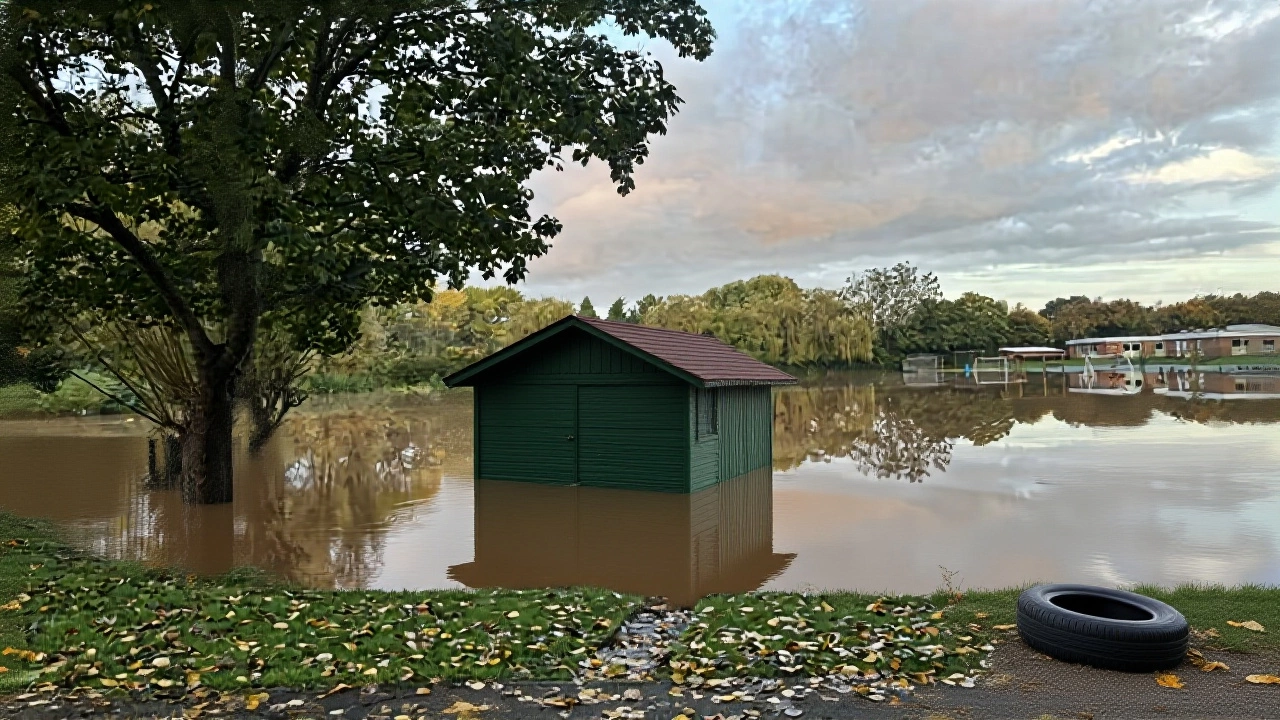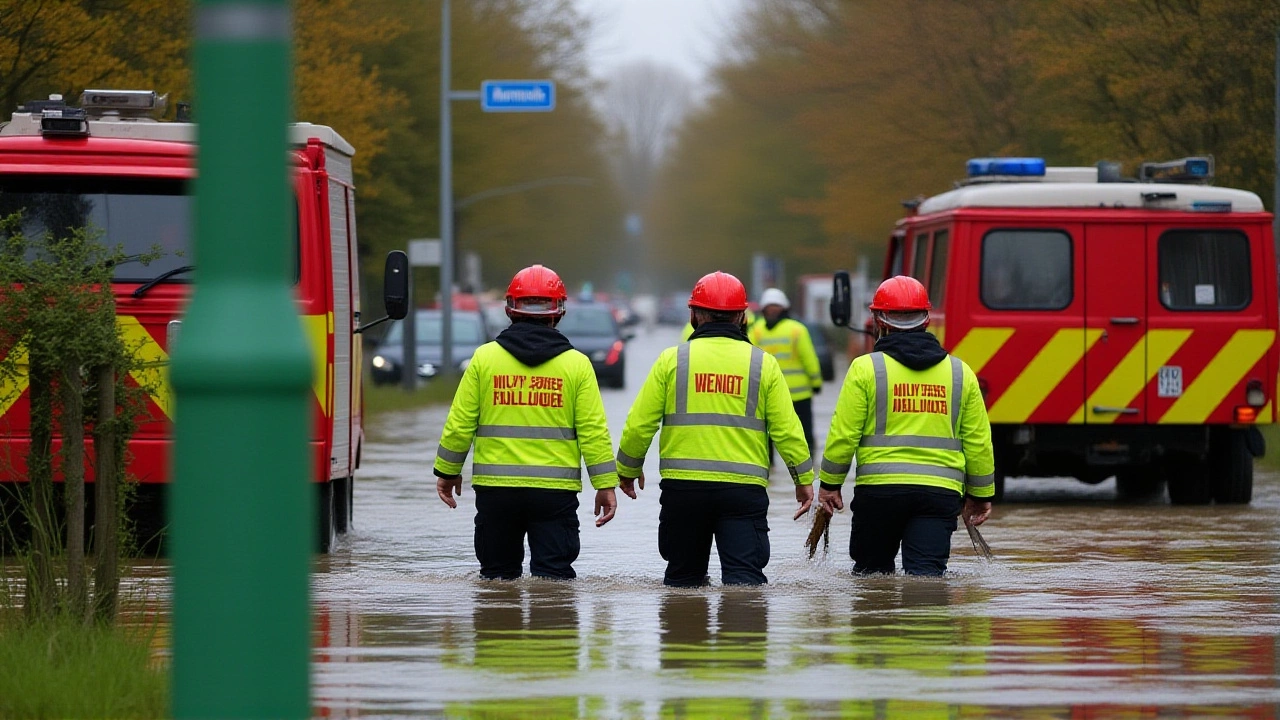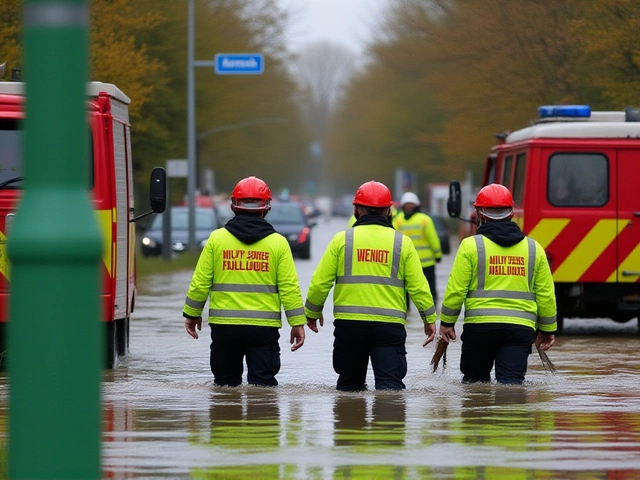When the River Wye burst its banks in the historic market town of Monmouth, Wales, on Friday, 14 November 2025, it didn’t just soak the streets—it shut down lives. By lunchtime, Monmouthshire County Council had already ordered three primary schools to close early, and by 2:15 p.m., Monmouth Comprehensive School followed suit. The storm wasn’t even at its peak yet. Within hours, the town was underwater. By Saturday, emergency crews were battling landslides, collapsed embankments, and roads turned into rivers. And still, the water kept rising.
Early Warnings, Rapid Escalation
The first signs came before dawn. At 2:45 a.m. on Saturday, 15 November 2025, Monmouthshire County Council issued its first major alert: “Multiple routes around Monmouth (including town) affected by flooding – avoid travel.” It wasn’t a suggestion. It was a lifeline. Residents who ignored it found themselves stranded. By midday, the R7 route near Forest Coal Pit had given way, its embankment sliding into the churning water. At 3 p.m., the Kentchurch to Grosmont Bridge—built in 1823 and still carrying local traffic—was declared unsafe. “Closed, avoid travel,” read the official notice.
Then came the A466. At 11:50 p.m. Saturday, the council confirmed the closure between Tintern and Llandogo—a vital artery linking southeast Wales to the English border. That same night, at 8:52 p.m., the council issued a chilling plea: “Due to the severity of the flooding... we would ask that people avoid trying to get into town or make unnecessary journeys at this time.” They weren’t just worried about traffic. They were worried about rescue teams being blocked.
The Town Underwater
What made Monmouth so vulnerable? Geography. Nestled where the River Monnow meets the River Wye, the town sits in a natural bowl. When heavy rain hits the hills of the Wye Valley, water funnels down—fast. Storm Claudia dumped over 100mm in 24 hours, more than the area typically sees in an entire November. The result? A scene straight out of a disaster film.
Independent confirmation came from Euronews, which published aerial footage on Saturday evening showing rooftops peeking through brown, churning water. “The Welsh town of Monmouth underwater,” their caption read. No narration. No music. Just silence and swirling water. The video went viral in Wales and across the UK. People in Cardiff and Newport saw it and thought: That could be us next.
By Sunday morning, 16 November 2025, four roads remained closed: Monmouth Town Center, B4347 Kentchurch Bridge, the R7 from Forest Coal Pit to the county boundary (now labeled “Closed, Landslide”), and the A466. Only the B4269 was open—but with a warning: “Drive with care.” No one was taking chances. School buses sat idle. Shopkeepers rolled up their shutters. Even the post office closed.

Emergency Response Under Pressure
Behind the scenes, Monmouthshire County Council was running a 24/7 war room. Staff worked from their homes, coordinating with fire services, the Welsh Government, and the Environment Agency. Their website became the town’s nervous system—updated hourly, sometimes every 30 minutes. But they weren’t just reporting. They were managing.
At 8:16 a.m. Sunday, their final update confirmed the closures but offered no reopening timeline. “The ongoing operation in Monmouth requires residents to avoid the town center entirely,” they wrote. That phrase—“ongoing operation”—was telling. It wasn’t just a flood response. It was a full-scale emergency mobilization. No casualties were reported, but that didn’t mean no one was at risk. Elderly residents in low-lying homes on St. Mary’s Street were being checked on by volunteers. A family in Overmonnow lost their basement to two feet of water. One woman told a local reporter: “We’ve lived here 40 years. Never seen anything like this.”
Why This Matters Beyond Monmouth
This wasn’t just a Welsh problem. Storm Claudia swept across England and Wales, but Monmouth became its most visible casualty. Climate scientists at Cardiff University pointed out that the frequency of extreme rainfall events in southeast Wales has increased by 37% since 2000. The infrastructure—roads, bridges, drainage—was designed for a 20th-century climate. It’s not holding up.
Monmouthshire County Council manages 90,000 people across 540 square miles. Many of its roads were built in the 1950s. The B4347? A narrow, winding route that hasn’t been widened since the 1970s. When the river swells, there’s nowhere for the water to go. And with climate models predicting more intense storms every decade, Monmouth isn’t an outlier—it’s a warning.

What’s Next?
As of Sunday night, cleanup had begun. Sandbags were being removed. Mud was being hosed from storefronts. But the council made one thing clear: this won’t be the last time. They’re now reviewing flood defense budgets and asking the Welsh Government for emergency funding to reinforce key crossings. Meanwhile, residents are asking: When will the next storm hit? And will we be ready?
Frequently Asked Questions
How did Storm Claudia compare to past floods in Monmouth?
Storm Claudia was the most severe flooding event in Monmouth since 2019, when the River Wye breached its banks after 80mm of rain in 48 hours. This time, rainfall exceeded 100mm in under 24 hours, and water levels rose faster. The 2019 flood affected 120 properties; early estimates suggest Claudia impacted over 200. What’s different now is the speed of response—council updates were hourly, and public alerts were issued within minutes of data confirmation.
Why were schools closed before the storm peaked?
Monmouthshire County Council follows a precautionary protocol for extreme weather. With forecasts predicting record rainfall and river levels, closing schools early on Friday allowed parents to get home before roads became impassable. It also freed up emergency vehicles from potential traffic delays. The decision was made in coordination with the Welsh Government’s weather advisory team, based on real-time hydrological data from the Environment Agency.
Which roads are still closed, and when might they reopen?
As of 16 November 2025, four roads remain closed: Monmouth Town Center, B4347 Kentchurch Bridge, the R7 route from Forest Coal Pit to the county boundary (due to landslide), and the A466 between Tintern and Llandogo. Reopening depends on structural inspections and drainage clearance. The council has not set a date, but engineers estimate at least 7–10 days for the R7 and B4347, which suffered ground failure. The A466 may reopen sooner if water recedes rapidly.
Is this linked to climate change?
Yes. According to the Met Office and Cardiff University’s Climate Research Group, the intensity and frequency of extreme rainfall events in southeast Wales have increased by 30–40% since 2000. Storm Claudia fits the pattern: a short, intense burst of rain overwhelming aging infrastructure. While no single storm can be blamed solely on climate change, the trend is unmistakable. Monmouth’s vulnerability is now a national case study in climate adaptation.
What can residents do to prepare for the next flood?
The council recommends registering for the Floodline Warnings Direct service, keeping emergency kits ready (including bottled water, batteries, and medication), and avoiding parking in known flood zones like Church Street and Monnow Street. Residents in high-risk areas are also being offered free sandbags through the council’s Community Resilience Program. A public meeting is scheduled for 23 November to discuss long-term flood defenses.
Why wasn’t more done to prevent this?
Flood defenses in Monmouth were last upgraded in 2007, with a £2.3 million project focused on the riverbanks near the town center. But that didn’t cover the R7 corridor or the Kentchurch Bridge area, which are underfunded rural routes. The council admits budget constraints have delayed critical upgrades. A 2024 audit flagged 11 bridges in Monmouthshire as “at risk,” but only three received funding. This event has reignited calls for a £15 million regional flood resilience plan.







